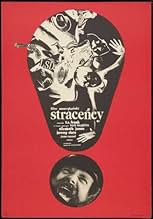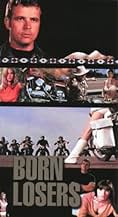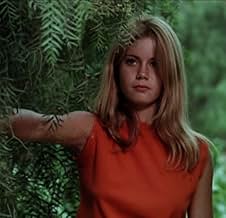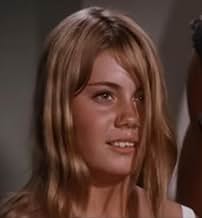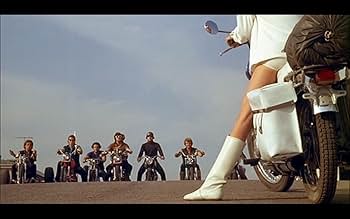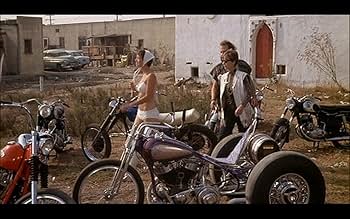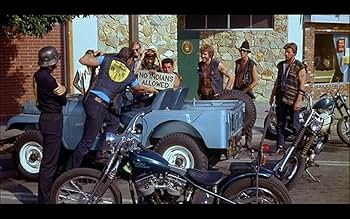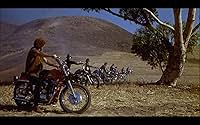Billy Jack battles a motorcycle gang in a small California beach town.Billy Jack battles a motorcycle gang in a small California beach town.Billy Jack battles a motorcycle gang in a small California beach town.
Robert Tessier
- Cueball
- (as Robert W. Tessier)
Stuart Lancaster
- Sheriff Harvey
- (as Stewart Lancaster)
- Director
- Writer
- All cast & crew
- Production, box office & more at IMDbPro
Featured reviews
If you like Billy Jack, this is for you. Over 2 hours of a leading actress that can't act, a leading man who stands still without expression, and an inane group of men who are supposed to be dangerous because they are slightly bizarre. Sprinkle in ten minutes of Billy kicking big donkey, and you have the formula.
Tom Laughlin knew a winner when he saw one and would use the main elements of this film in all of his future Billy Jack movies. In later films, his real-life wife would take over the role of the leading actress that can't act.
This is a very low-budget movie. Future Billy Jack against the world movies had a couple more bucks. But true to form, as in all Billy Jack movies, there is no competent acting anywhere.
Personally, none of this stuff turns me off of Billy Jack movies. In one movie, I see it for the gas station scene. In another, I want to see Billy put his right foot up against the guy's left ear. In a third, I want to see him shoot it out.
For an anti-war pinko, Laughlin sure knows how to create some nice fight scenes. If the man would have moved a few more times per pic, he would have been a major star. But his style is to stand around for most of the movie with a deadpan expression, and then finally kick some butt.
The Billy Jack movies are a lot like chitlins, limburger cheese, or kim chee. If you like that stuff, you don't mind the smell.
This one stinks to high heaven.
But it's a Billy Jack stink.
Tom Laughlin knew a winner when he saw one and would use the main elements of this film in all of his future Billy Jack movies. In later films, his real-life wife would take over the role of the leading actress that can't act.
This is a very low-budget movie. Future Billy Jack against the world movies had a couple more bucks. But true to form, as in all Billy Jack movies, there is no competent acting anywhere.
Personally, none of this stuff turns me off of Billy Jack movies. In one movie, I see it for the gas station scene. In another, I want to see Billy put his right foot up against the guy's left ear. In a third, I want to see him shoot it out.
For an anti-war pinko, Laughlin sure knows how to create some nice fight scenes. If the man would have moved a few more times per pic, he would have been a major star. But his style is to stand around for most of the movie with a deadpan expression, and then finally kick some butt.
The Billy Jack movies are a lot like chitlins, limburger cheese, or kim chee. If you like that stuff, you don't mind the smell.
This one stinks to high heaven.
But it's a Billy Jack stink.
Given its low budget, this is not a bad movie. A motorcycle gang, led by the scruffy Jeremy Slate, terrorizes a small California town, and in the process rapes several college girls. There's lots of tough talk, motorcycle noise, and violence, as you would expect for a biker film.
Of course, to balance out all the villainous mayhem, you gotta have a hero on the scene. And for the era in which the film was made, there was no better hero than the charismatic loner, half-breed Billy Jack, played with serene gusto by Tom Laughlin. He's a one-man show of moral and physical strength, as he outwits and outfights the biker roughnecks. The film makes the point that bad parenting and ineptness in traditional law enforcement foster an environment conducive to delinquency.
Interestingly, although this is the first Billy Jack film, Laughlin played a similar role ten years earlier, in a movie called "The Delinquents" (1957). His character was Scotty, a good guy teenager who gets mixed up with a bunch of high school hoodlums. Whereas in "The Delinquents" all the villains are kids who drive around in jalopies, in "The Born Losers", the kids have grown into adults who ride motorcycles.
In "The Born Losers" the characters tend to be stereotypes. In a time period that immediately preceded the women's lib movement, the film's female characters are very, very subservient. The film's plot does depend on contrivances to some extent. Dialogue lacks subtext. Production design is ... colorful. And the costumes reek of late 60's garish "hip" (love those pink walls and pink clothes), all perfectly in sync with the Age of Aquarius. Tom Laughlin's direction is excellent. Color cinematography is very good. The outdoor scenery is wonderful, as is the music in the opening title sequence.
I've seen a number of biker films. "The Born Losers" is one of the best. It was highly successful at the box office, and led to later Billy Jack films. It has a cinematic style that is almost iconoclastic; not insignificantly, it preceded "Easy Rider" by a couple of years. Such was the impact of "The Born Losers".
Of course, to balance out all the villainous mayhem, you gotta have a hero on the scene. And for the era in which the film was made, there was no better hero than the charismatic loner, half-breed Billy Jack, played with serene gusto by Tom Laughlin. He's a one-man show of moral and physical strength, as he outwits and outfights the biker roughnecks. The film makes the point that bad parenting and ineptness in traditional law enforcement foster an environment conducive to delinquency.
Interestingly, although this is the first Billy Jack film, Laughlin played a similar role ten years earlier, in a movie called "The Delinquents" (1957). His character was Scotty, a good guy teenager who gets mixed up with a bunch of high school hoodlums. Whereas in "The Delinquents" all the villains are kids who drive around in jalopies, in "The Born Losers", the kids have grown into adults who ride motorcycles.
In "The Born Losers" the characters tend to be stereotypes. In a time period that immediately preceded the women's lib movement, the film's female characters are very, very subservient. The film's plot does depend on contrivances to some extent. Dialogue lacks subtext. Production design is ... colorful. And the costumes reek of late 60's garish "hip" (love those pink walls and pink clothes), all perfectly in sync with the Age of Aquarius. Tom Laughlin's direction is excellent. Color cinematography is very good. The outdoor scenery is wonderful, as is the music in the opening title sequence.
I've seen a number of biker films. "The Born Losers" is one of the best. It was highly successful at the box office, and led to later Billy Jack films. It has a cinematic style that is almost iconoclastic; not insignificantly, it preceded "Easy Rider" by a couple of years. Such was the impact of "The Born Losers".
Loner Billy Jack (Tom Laughlin), just returned from Viet Nam, pits himself against a vicious motorcycle gang who are terrorizing a California town, protecting a rape victim and standing alone when even the police are reluctant to act.
This is one of the best of its kind. Made on a shoestring budget the tight storyline allows for few frills but plenty of classic hero and villain tension. In-your-face violence for its time, only a little martial-arts action (compared to the later BJ films) but all the ingredients are on hand for a character who is destined to become an American screen icon.
The nattering nabobs can kavetch about bad acting until their faces turn blue---Billy Jack is what he is, and Laughlin plays him to perfection. Particular credit goes to veteran actor Jeremy Slate as the complicated, arrogant gang leader, and again to Laughlin, for writing the part. Laughlin's villains have an element of sympathy. They may be monsters, but they have reasons for the way they behave and this makes them more human.
Look for an early walk-on by Laughlin's wife and later screen partner Delores Taylor (also his executive producer and co-writer)and their son and daughter (she would have a substantial role in following BJ flicks).
Also on hand is one of our favorite heavies, Robert Tessier as CueBall, sporting thick dark hair before he adopted his well-known shaved-head look. Tessier, a military vet and stunt man, was also the stunt adviser for the film.
Classic hero defending his girl against despicable bad guys makes for ONE TERRIFIC MOVIE. If you like this one check out BILLY JACK and DEFIANCE (Jan-Michael Vincent).
This is one of the best of its kind. Made on a shoestring budget the tight storyline allows for few frills but plenty of classic hero and villain tension. In-your-face violence for its time, only a little martial-arts action (compared to the later BJ films) but all the ingredients are on hand for a character who is destined to become an American screen icon.
The nattering nabobs can kavetch about bad acting until their faces turn blue---Billy Jack is what he is, and Laughlin plays him to perfection. Particular credit goes to veteran actor Jeremy Slate as the complicated, arrogant gang leader, and again to Laughlin, for writing the part. Laughlin's villains have an element of sympathy. They may be monsters, but they have reasons for the way they behave and this makes them more human.
Look for an early walk-on by Laughlin's wife and later screen partner Delores Taylor (also his executive producer and co-writer)and their son and daughter (she would have a substantial role in following BJ flicks).
Also on hand is one of our favorite heavies, Robert Tessier as CueBall, sporting thick dark hair before he adopted his well-known shaved-head look. Tessier, a military vet and stunt man, was also the stunt adviser for the film.
Classic hero defending his girl against despicable bad guys makes for ONE TERRIFIC MOVIE. If you like this one check out BILLY JACK and DEFIANCE (Jan-Michael Vincent).
The first "Billy Jack" film is a serious examination of rape and personal cowardice disguised as a biker/drug exploitation film. It manages to satisfy on both counts. No nudity, lots of outrageous clothing, and plenty of nazi bikers. Not quite as good as its sequel (which was written previously) but also not so preachy and talky. Dig the "nature carnage" at the film's beginning. Decent photography (marred in the DVD presentation by pan and scan process), but mid to low grade actors. Russell appears as a burnt-out, harried mom. Is she really acting? She's way over the top, but fun as always.
p.s. (2008, second viewing) p.s. the movie isn't going to appeal to everyone, but it's coming from a good place compared to a lot of exploitation films. There's a lot of classic Hollywood here, Tom Laughlin drawing on a lot of his roots. Like "Billy Jack" this movie is a very passionate statement against rape and it condemns society's attitude about rape. But because the victims are so beautiful, frankly the movie feels more exploitative and less serious than the more successful sequel. You could look on this movie as a learning experience for Laughlin, but it's a very interesting drive-in biker movie in and of itself, very different and more carefully put together than a lot of its brethren. For example this time around I noticed that the film can be seen as an anti-Western -- as opposed to the stereotypical concept of a white man rescuing the white virgins from the "indians", here we have an ostensibly Native American hero rescuing the white women from white bikers (bikes and jeeps standing in for horses and stagecoaches in the traditional Western iconography of course).
p.s. (2008, second viewing) p.s. the movie isn't going to appeal to everyone, but it's coming from a good place compared to a lot of exploitation films. There's a lot of classic Hollywood here, Tom Laughlin drawing on a lot of his roots. Like "Billy Jack" this movie is a very passionate statement against rape and it condemns society's attitude about rape. But because the victims are so beautiful, frankly the movie feels more exploitative and less serious than the more successful sequel. You could look on this movie as a learning experience for Laughlin, but it's a very interesting drive-in biker movie in and of itself, very different and more carefully put together than a lot of its brethren. For example this time around I noticed that the film can be seen as an anti-Western -- as opposed to the stereotypical concept of a white man rescuing the white virgins from the "indians", here we have an ostensibly Native American hero rescuing the white women from white bikers (bikes and jeeps standing in for horses and stagecoaches in the traditional Western iconography of course).
This movie is interesting on many levels. Although it contains a few shocking scenes (if viewed unedited) it still comes across as kind of campy. When a girl on a motorcycle p***es off a motorcycle gang the fun begins. First of all, the girl on the cute little scooter type motorcyle looks like she just finished a gig on the "Hullabaloo" TV show complete with her matching go-go boots and bikini. She is kinda cute except she has a haircut that looks like they put a bowl on her head and cut around it. (She could have at least wore a "Bob's Big Boy Cascade" to sex it up a bit). She mouths off to the group of scumbags who all look like rejects from the Manson Family.
One shocking scene for 1967 is the part where two gang members french kiss (they are both men)! This is to illustrate the free-sex attitude of the era and supposedly (I am guessing here) to show what a bunch of degenerates these guys are.
Jane Russell is over the top here as a drunken, floozy mother of a teenage trollop who does a strip tease in her trailer park that has to be seen to be believed. The look on her face while stripping is somewhere between orgasmic and root canal. RENT THIS AND HAVE FUN!
One shocking scene for 1967 is the part where two gang members french kiss (they are both men)! This is to illustrate the free-sex attitude of the era and supposedly (I am guessing here) to show what a bunch of degenerates these guys are.
Jane Russell is over the top here as a drunken, floozy mother of a teenage trollop who does a strip tease in her trailer park that has to be seen to be believed. The look on her face while stripping is somewhere between orgasmic and root canal. RENT THIS AND HAVE FUN!
Did you know
- TriviaBased on a real incident in 1964 when members of the Hell's Angels motorcycle gang were arrested for raping five girls in Monterey, California.
- GoofsAt the beginning of the scene at the Shorns' house, the LP record Jodell is looking at while talking to her mother changes from David Rose's 'The Stripper' into 'Music to Strip By' and then back again. These were both actual stripper-themed LPs released in the 1960s (perhaps suggesting Mrs. Shorn's previous occupation?)
- Quotes
Vicky Barrington: Oh--Why do you call him "Crabs"?
Daniel 'Danny' Carmody: 'Cause he's got 'em. Ever since he caught the disease from some broad he's been crawlin' with 'em. He's okay, though, he's a good cat.
Vicky Barrington: Oh, I'm sure.
- ConnectionsFeatured in Dusk to Dawn Drive-In Trash-o-Rama Show Vol. 2 (1996)
- SoundtracksBilly Jack's Theme
Written and Produced by Mike Curb
Co-produced by Al Simms
Performed by Davie Allan with The Arrows (as The Sidewalk Sounds)
Details
- Release date
- Country of origin
- Language
- Also known as
- Nacidos para perder
- Filming locations
- Main Street, Seal Beach, California, USA(Biker rally: Irisher [121], Condo's Rock Shop [125], Raines Radio [127], etc.)
- Production companies
- See more company credits at IMDbPro
Box office
- Budget
- $360,000 (estimated)
Contribute to this page
Suggest an edit or add missing content

Top Gap
By what name was Le Credo de la violence (1967) officially released in India in English?
Answer


